How Good Are Global Layers for Mapping Rural Settlements? Evidence from China
Abstract
:1. Introduction
2. Literature Review
3. Study Area and Data
3.1. Study Area
3.2. Data
4. Methodology
4.1. Method of Sampling
4.2. Establishment of Validation Sample Units
4.3. Accuracy Assessment Indicators
5. Results
5.1. Sampling
5.2. Accuracy Assessment
5.2.1. Omission Test
5.2.2. Area Test
5.2.3. Pixel-Based Accuracy Test
6. Discussion
6.1. Map Resolution
6.2. Type of Rural Settlements
6.3. Spatial Variation across Regions
6.4. Balance between PA and UA
6.5. Rural Roads
6.6. The Continuous Value of Built-Up Probability
6.7. Pixel Values of the Built Year
7. Conclusions
Author Contributions
Funding
Institutional Review Board Statement
Informed Consent Statement
Data Availability Statement
Acknowledgments
Conflicts of Interest
References
- United Nations, Department of Economic and Social Affairs. World Urbanization Prospects: 2018 Revision; UN DESA: New York, NY, USA, 2018. [Google Scholar]
- Brüntrup, M.; Messner, D. Global Trends and the Future of Rural Areas. Agric. Rural Dev. 2007, 1, 48–51. [Google Scholar]
- United Nations. Transforming Our World: The 2030 Agenda for Sustainable Development; United Nations: New York, NY, USA, 2015. [Google Scholar]
- Tian, Y.; Kong, X.; Liu, Y. Combining Weighted Daily Life Circles and Land Suitability for Rural Settlement Reconstruction. Habitat Int. 2018, 76, 1–9. [Google Scholar] [CrossRef]
- Guo, K.; Huang, Y.; Chen, D. Analysis of the Expansion Characteristics of Rural Settlements Based on Scale Growth Function in Himalayan Region. Land 2022, 11, 450. [Google Scholar] [CrossRef]
- Tan, M.; Li, X. The Changing Settlements in Rural Areas under Urban Pressure in China: Patterns, Driving Forces and Policy Implications. Landsc. Urban Plan. 2013, 120, 170–177. [Google Scholar] [CrossRef]
- Chen, Z.; Liu, Y.; Feng, W.; Li, Y.; Li, L. Study on Spatial Tropism Distribution of Rural Settlements in the Loess Hilly and Gully Region Based on Natural Factors and Traffic Accessibility. J. Rural Stud. 2019, 93, 441–448. [Google Scholar] [CrossRef]
- Song, W.; Li, H. Spatial Pattern Evolution of Rural Settlements from 1961 to 2030 in Tongzhou District, China. Land Use Policy 2020, 99, 105044. [Google Scholar] [CrossRef]
- Gorbenkova, E.; Shcherbina, E. Historical-Genetic Features in Rural Settlement System: A Case Study from Mogilev District (Mogilev Oblast, Belarus). Land 2020, 9, 165. [Google Scholar] [CrossRef]
- Song, W.; Liu, M. Assessment of Decoupling between Rural Settlement Area and Rural Population in China. Land Use Policy 2014, 39, 331–341. [Google Scholar] [CrossRef]
- CIESIN (Center for International Earth Science Information Network). Global Rural-Urban Mapping Project (GRUMP) Alpha Version; NASA Socioeconomic Data and Applications Center (SEDAC): Palisades, NY, USA, 2004.
- Schneider, A.; Friedl, M.A.; Potere, D. A New Map of Global Urban Extent from MODIS Satellite Data. Environ. Res. Lett. 2009, 4, 044003. [Google Scholar] [CrossRef]
- Schneider, A.; Friedl, M.A.; Potere, D. Mapping Global Urban Areas Using MODIS 500-m Data: New Methods and Datasets Based on ‘Urban Ecoregions’. Remote Sens. Environ. 2010, 114, 1733–1746. [Google Scholar] [CrossRef]
- European Space Agency. Land Cover CCI Product User Guide Version 2.0.; ESA: Paris, France, 2017. [Google Scholar]
- Arino, O.; Gross, D.; Ranera, F.; Leroy, M.; Bicheron, P.; Brockman, C.; Defourny, P.; Vancutsem, C.; Achard, F.; Durieux, L.; et al. GlobCover: ESA Service for Global Land Cover from MERIS. In Proceedings of the 2007 IEEE International Geoscience and Remote Sensing Symposium, Barcelona, Spain, 23–28 July 2007; pp. 2412–2415. [Google Scholar] [CrossRef]
- Sulla-Menashe, D.; Friedl, M.A. User Guide to Collection 6 MODIS Land Cover (MCD12Q1 and MCD12C1) Product; USGS: Reston, VA, USA, 2018. [CrossRef]
- Potere, D.; Schneider, A.; Angel, S.; Civco, D.L. Mapping Urban Areas on a Global Scale: Which of the Eight Maps Now Available Is More Accurate? Int. J. Remote Sens. 2009, 30, 6531–6558. [Google Scholar] [CrossRef]
- Klotz, M.; Kemper, T.; Geiß, C.; Esch, T.; Taubenböck, H. How Good Is the Map? A Multi-Scale Cross-Comparison Framework for Global Settlement Layers: Evidence from Central Europe. Remote Sens. Environ. 2016, 178, 191–212. [Google Scholar] [CrossRef]
- Marconcini, M.; Metz-Marconcini, A.; Üreyen, S.; Palacios-Lopez, D.; Hanke, W.; Bachofer, F.; Zeidler, J.; Esch, T.; Gorelick, N.; Kakarla, A.; et al. Outlining Where Humans Live, the World Settlement Footprint 2015. Sci. Data 2020, 7, 242. [Google Scholar] [CrossRef]
- Esch, T.; Heldens, W.; Hirner, A.; Keil, M.; Marconcini, M.; Roth, A.; Zeidler, J.; Dech, S.; Strano, E. Breaking New Ground in Mapping Human Settlements from Space—The Global Urban Footprint. ISPRS J. Photogramm. Remote Sens. 2017, 134, 30–42. [Google Scholar] [CrossRef]
- Gong, P.; Wang, J.; Yu, L.; Zhao, Y.; Zhao, Y.; Liang, L.; Niu, Z.; Huang, X.; Fu, H.; Liu, S.; et al. Finer Resolution Observation and Monitoring of Global Land Cover: First Mapping Results with Landsat TM and ETM+ Data. Int. J. Remote Sens. 2013, 34, 2607–2654. [Google Scholar] [CrossRef]
- Zanaga, D.; Kerchove, R.; Van De Keersmaecker, W. ESA WorldCover 10 m 2020 V100. 2021. Available online: https://pure.iiasa.ac.at/id/eprint/17832/ (accessed on 12 August 2022).
- Zhang, X.; Liu, L.; Zhao, T.; Gao, Y.; Chen, X.; Mi, J. GISD30: Global 30-m Impervious Surface Dynamic Dataset from 1985 to 2020 Using Time-Series Landsat Imagery on the Google Earth Engine Platform. Earth Syst. Sci. Data Discuss. 2022, 14, 1831–1856. [Google Scholar] [CrossRef]
- Huang, X.; Li, J.; Yang, J.; Zhang, Z.; Li, D.; Liu, X. 30 m Global Impervious Surface Area Dynamics and Urban Expansion Pattern Observed by Landsat Satellites: From 1972 to 2019. Sci. China Earth Sci. 2021, 64, 1922–1933. [Google Scholar] [CrossRef]
- Gong, P.; Li, X.; Wang, J.; Bai, Y.; Chen, B.; Hu, T.; Liu, X.; Xu, B.; Yang, J.; Zhang, W.; et al. Annual Maps of Global Artificial Impervious Area (GAIA) between 1985 and 2018. Remote Sens. Environ. 2020, 236, 111510. [Google Scholar] [CrossRef]
- De Colstoun, E.C.B.; Huang, C.; Wang, P.; Tilton, J.C.; Tan, B.; Phillips, J.; Niemczura, S.; Ling, P.-Y.; Wolfe, R. Documentation for the Global Man-Made Impervious Surface (GMIS) Dataset from Landsat; NASA Socioeconomic Data and Applications Center: Palisades, NY, USA, 2017.
- Jun, C.; Ban, Y.; Li, S. Open Access to Earth Land-Cover Map. Nature 2014, 514, 434. [Google Scholar] [CrossRef]
- Karra, K.; Kontgis, C.; Statman-Weil, Z.; Mazzariello, J.C.; Mathis, M.; Brumby, S.P. Global land use/land cover with Sentinel 2 and deep learning. In Proceedings of the 2021 IEEE International Geoscience and Remote Sensing Symposium IGARSS, Brussels, Belgium, 11–16 July 2021; pp. 4704–4707. [Google Scholar] [CrossRef]
- Corbane, C.; Syrris, V.; Sabo, F.; Politis, P.; Melchiorri, M.; Pesaresi, M.; Soille, P.; Kemper, T. Convolutional Neural Networks for Global Human Settlements Mapping from Sentinel-2 Satellite Imagery. Neural Comput. Appl. 2021, 33, 6697–6720. [Google Scholar] [CrossRef]
- Im, J.; Lu, Z.; Rhee, J.; Quackenbush, L.J. Impervious Surface Quantification Using a Synthesis of Artificial Immune Networks and Decision/Regression Trees from Multi-Sensor Data. Remote Sens. Environ. 2012, 117, 102–113. [Google Scholar] [CrossRef]
- Zhou, Y.; Wang, Y.Q. Extraction of Impervious Surface Areas from High Spatial Resolution Imagery by Multiple Agent Segmentation and Classification. Photogramm. Eng. Remote Sens. 2008, 74, 857–868. [Google Scholar] [CrossRef]
- Jensen, J.R.; Cowen, D.C. Remote Sensing of Urban/Suburban Infrastructure and Socio-Economic Attributes. Photogramm. Eng. Remote Sens. 1999, 65, 611–622. [Google Scholar]
- Wang, Y.; Li, M. Urban Impervious Surface Detection From Remote Sensing Images: A Review of the Methods and Challenges. IEEE Geosci. Remote Sens. Mag. 2019, 7, 64–93. [Google Scholar] [CrossRef]
- Jia, Y.; Tang, L.; Wang, L. Influence of Ecological Factors on Estimation of Impervious Surface Area Using Landsat 8 Imagery. Remote Sens. 2017, 9, 751. [Google Scholar] [CrossRef]
- Sun, G.; Chen, X.; Ren, J.; Zhang, A.; Jia, X. Stratified Spectral Mixture Analysis of Medium Resolution Imagery for Impervious Surface Mapping. Int. J. Appl. Earth Obs. Geoinf. 2017, 60, 38–48. [Google Scholar] [CrossRef]
- Mück, M.; Klotz, M.; Taubenbock, H. Validation of the DLR Global Urban Footprint in Rural Areas: A Case Study for Burkina Faso. In Proceedings of the 2017 Joint Urban Remote Sensing Event (JURSE), Dubai, United Arab Emirates, 6–8 March 2017; pp. 6–9. [Google Scholar] [CrossRef]
- Conrad, C.; Rudloff, M.; Abdullaev, I.; Thiel, M.; Löw, F.; Lamers, J.P.A. Measuring Rural Settlement Expansion in Uzbekistan Using Remote Sensing to Support Spatial Planning. Appl. Geogr. 2015, 62, 29–43. [Google Scholar] [CrossRef]
- Zheng, X.; Wu, B.; Weston, M.V.; Zhang, J.; Gan, M.; Zhu, J.; Deng, J.; Wang, K.; Teng, L. Rural Settlement Subdivision by Using Landscape Metrics as Spatial Contextual Information. Remote Sens. 2017, 9, 486. [Google Scholar] [CrossRef]
- Ji, H.; Li, X.; Wei, X.; Liu, W.; Zhang, L.; Wang, L. Mapping 10-m Resolution Rural Settlements Using Multi-Source Remote Sensing Datasets with the Google Earth Engine Platform. Remote Sens. 2020, 12, 2832. [Google Scholar] [CrossRef]
- Chen, Y.; Ge, Y. Spatial Point Pattern Analysis on the Villages in China’s Poverty-Stricken Areas. Procedia Environ. Sci. 2015, 27, 98–105. [Google Scholar] [CrossRef]
- National Bureau of Statistics of China. Announcement on Updating National Statistical Code for Zoning and Code for Urban-Rural Division. Available online: http://www.stats.gov.cn/tjsj/tjbz/tjyqhdmhcxhfdm/2021/index.html (accessed on 12 August 2022).
- National Bureau of Statistics of China. Rules for Compiling Zoning Codes and Urban-Rural Division Codes for Statistics. Available online: http://www.stats.gov.cn/tjsj/tjbz/200911/t20091125_8667.html (accessed on 12 August 2022).
- Wang, P.; Huang, C.; Brown de Colstoun, E.C.; Tilton, J.C.; Tan, B. Global Human Built-up And Settlement Extent (HBASE) Dataset from Landsat; NASA Socioeconomic Data and Applications Center (SEDAC): Palisades, NY, USA, 2017.
- Chen, B.; Xu, B.; Zhu, Z.; Yuan, C.; Suen, H.P.; Guo, J.; Xu, N.; Li, W.; Zhao, Y.; Yang, J. Stable Classification with Limited Sample: Transferring a 30-m Resolution Sample Set Collected in 2015 to Mapping 10-m Resolution Global Land Cover in 2017. Sci. Bull. 2019, 64, 370–373. [Google Scholar]
- Liu, X.; Huang, Y.; Xu, X.; Li, X.; Li, X.; Ciais, P.; Lin, P.; Gong, K.; Ziegler, A.D.; Chen, A. High-Spatiotemporal-Resolution Mapping of Global Urban Change from 1985 to 2015. Nat. Sustain. 2020, 3, 564–570. [Google Scholar] [CrossRef]
- Huang, X.; Huang, J.; Wen, D.; Li, J. An Updated MODIS Global Urban Extent Product (MGUP) from 2001 to 2018 Based on an Automated Mapping Approach. Int. J. Appl. Earth Obs. Geoinf. 2021, 95, 102255. [Google Scholar] [CrossRef]
- Corbane, C.; Sabo, F.; Politis, P.; Vasileos, S. GHS-BUILT-S2 R2020A: Built-up Grid Derived from Sentinel-2 Global Image Composite for Reference Year 2018 Using Convolutional Neural Networks (GHS-S2Net); European Commission, Joint Research Centre (JRC): Brussels, Belgium, 2020. [Google Scholar]
- Clark, M.L.; Aide, T.M.; Grau, H.R.; Riner, G. A Scalable Approach to Mapping Annual Land Cover at 250 m Using MODIS Time Series Data: A Case Study in the Dry Chaco Ecoregion of South America. Remote Sens. Environ. 2010, 114, 2816–2832. [Google Scholar] [CrossRef]
- Yang, Y.; Xiao, P.; Feng, X.; Li, H. Accuracy Assessment of Seven Global Land Cover Datasets over China. ISPRS J. Photogramm. Remote Sens. 2017, 125, 156–173. [Google Scholar] [CrossRef]
- Li, B.Y.; Pan, B.; Cheng, W.; Han, J.; Qi, D.; Zhu, C. Research on Geomorphological Regionalization of China. Acta Geogr. Sin. 2013, 68, 291–306. [Google Scholar]
- Reuter, H.I.; Nelson, A.; Jarvis, A. An Evaluation of Void-filling Interpolation Methods for SRTM Data. Int. J. Geogr. Inf. Sci. 2007, 21, 983–1008. [Google Scholar] [CrossRef]
- Shi, Z.; Ma, L.; Zhang, W.; Gong, M. Differentiation and Correlation of Spatial Pattern and Multifunction in Rural Settlements Considering Topographic Gradients: Evidence from Loess Hilly Region, China. J. Environ. Manag. 2022, 315, 115127. [Google Scholar] [CrossRef] [PubMed]
- Seymour, L. Spatial Data Analysis: Theory and Practice; Cambridge University Press: Cambridge, UK, 2005; Volume 100, ISBN 9780511049866. [Google Scholar]
- Dunn, R.; Harrison, A.R. Two-Dimensional Systematic Sampling of Land Use. J. R. Stat. Soc. Ser. C Appl. Stat. 1993, 42, 585–601. [Google Scholar] [CrossRef]
- Tian, G.; Qiao, Z.; Zhang, Y. The Investigation of Relationship between Rural Settlement Density, Size, Spatial Distribution and Its Geophysical Parameters of China Using Landsat TM Images. Ecol. Model. 2012, 231, 25–36. [Google Scholar] [CrossRef]
- Mathew, O.O.; Sola, A.F.; Oladiran, B.H.; Amos, A.A. Efficiency of Neyman Allocation Procedure over Other Allocation Procedures in Stratified Random Sampling. Am. J. Theor. Appl. Stat. 2013, 2, 122–127. [Google Scholar] [CrossRef]
- National Bureau of Statistics of China. Statistical Communiqué of the People’s Republic of China on the 2021 National Economic and Social Development; NBS: Beijing, China, 2022.
- Fang, C. Important Progress and Future Direction of Studies on China’s Urban Agglomerations. J. Geogr. Sci. 2015, 25, 1003–1024. [Google Scholar] [CrossRef]
- Foody, G.M. What Is the Difference between Two Maps? A Remote Senser’s View. J. Geogr. Syst. 2006, 8, 119–130. [Google Scholar] [CrossRef]
- İzgi, B.D. Resilience of Rural Settlement Morphology Dynamics: The Case of Kargalı District (Village). J. Des. Resil. Arch. Plan. 2022, 3, 112–126. [Google Scholar]
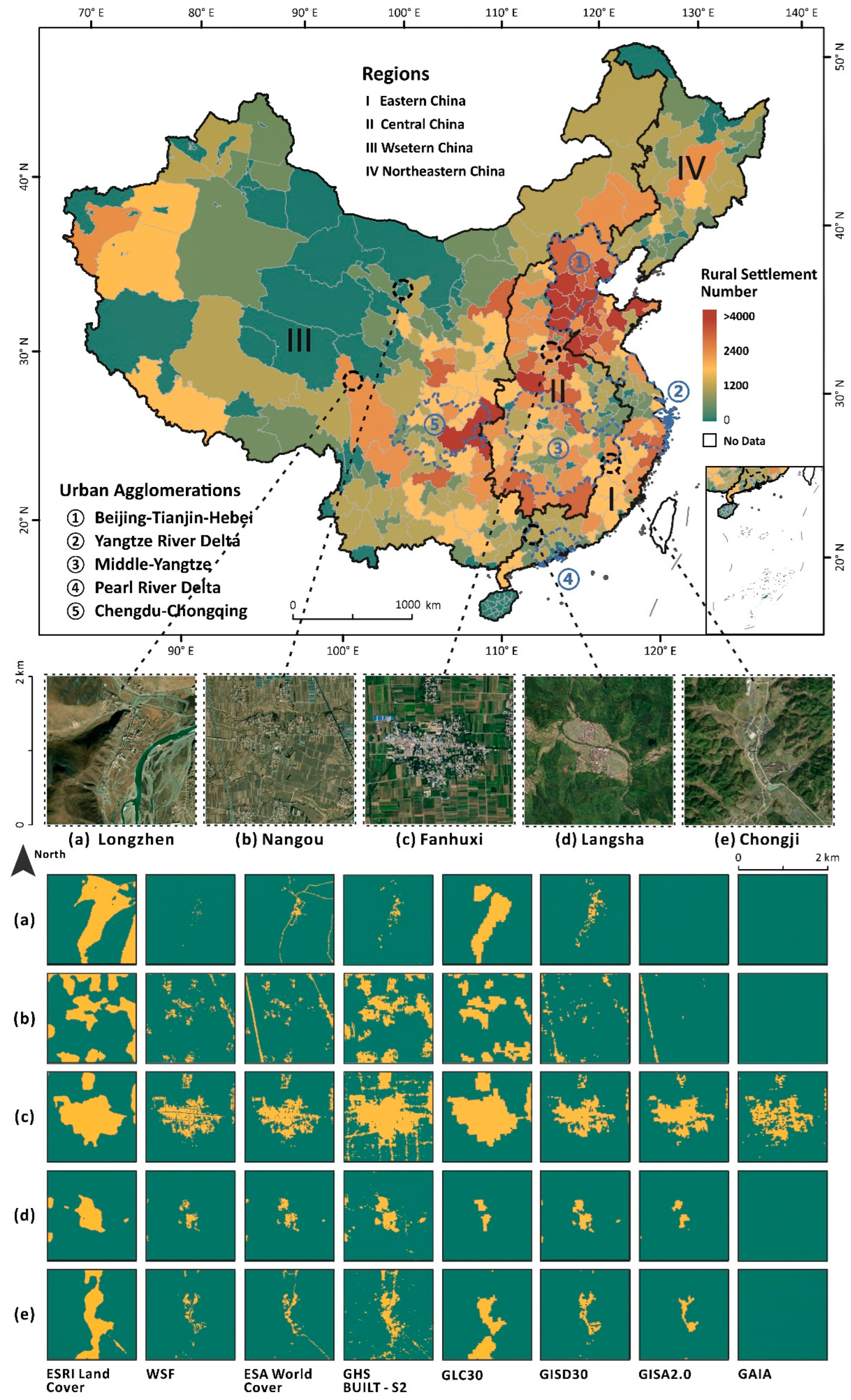
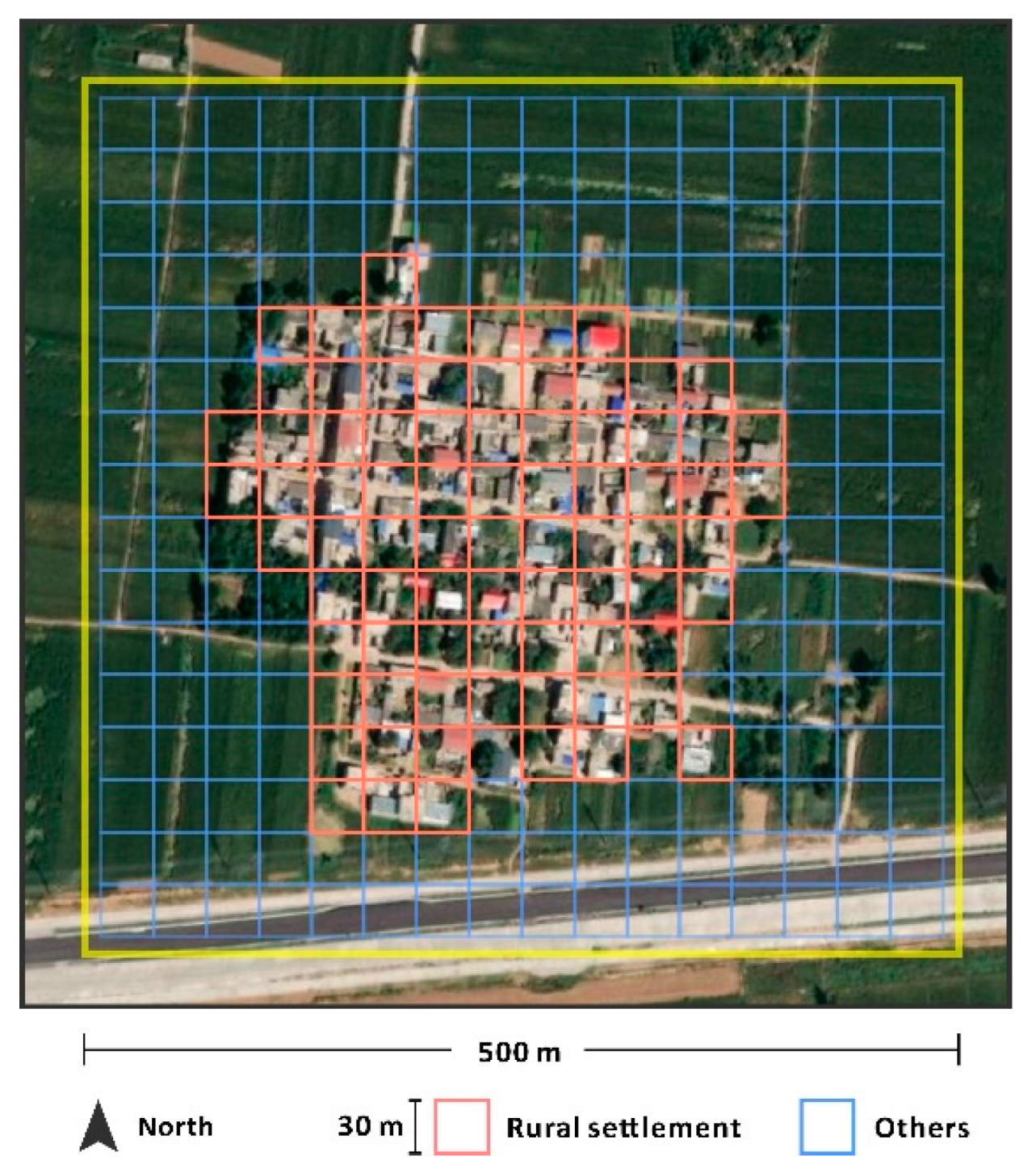
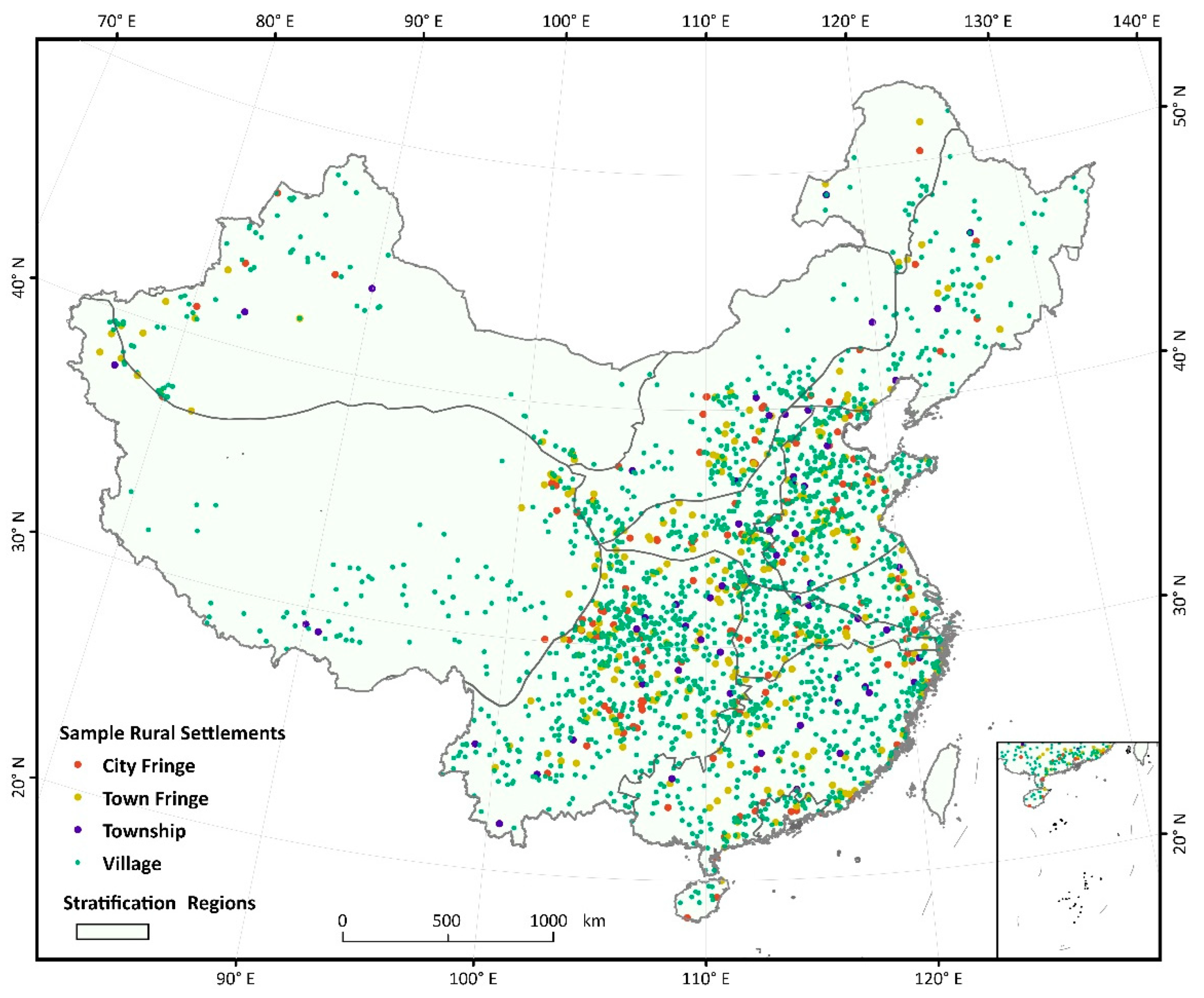
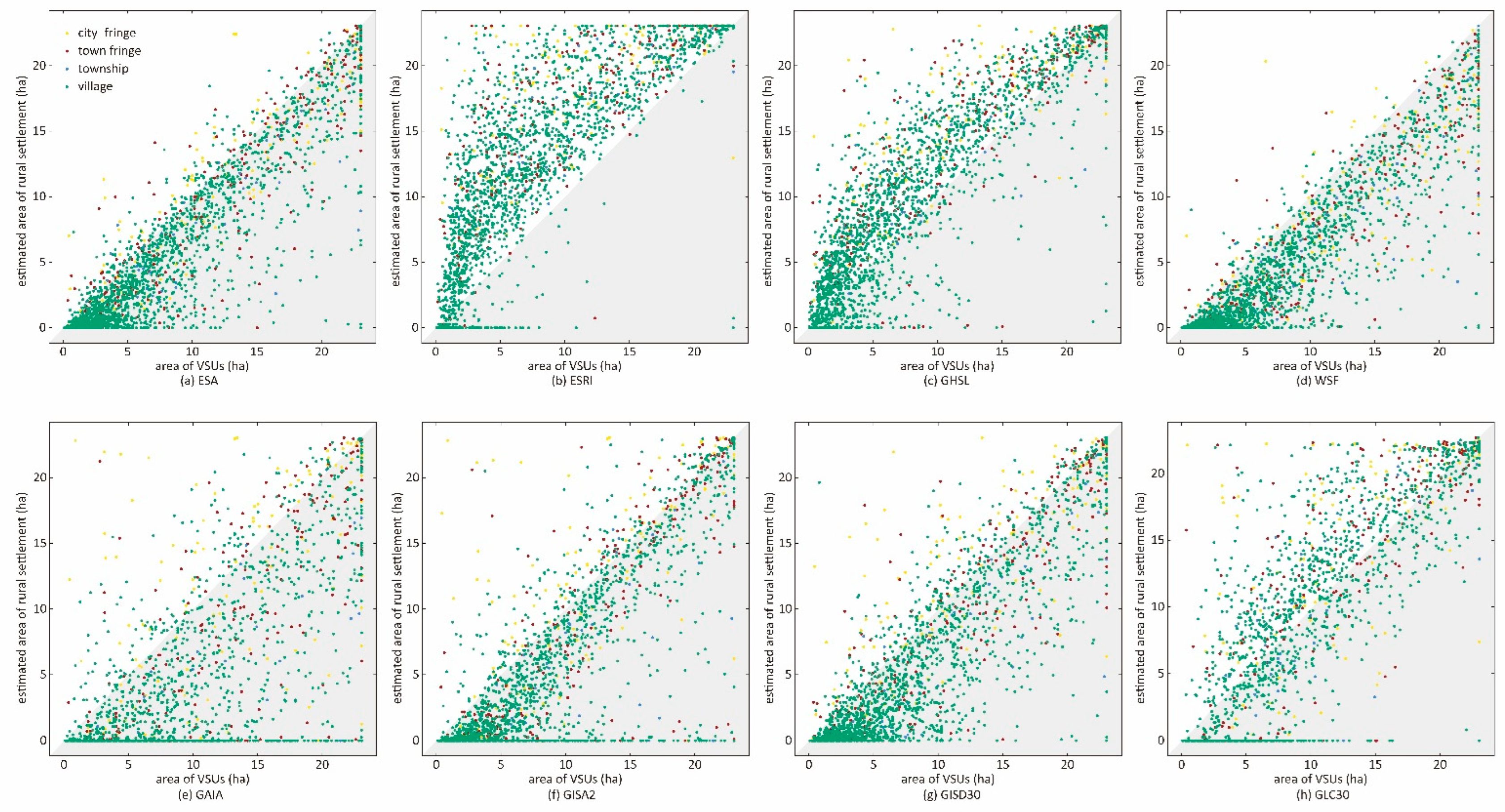
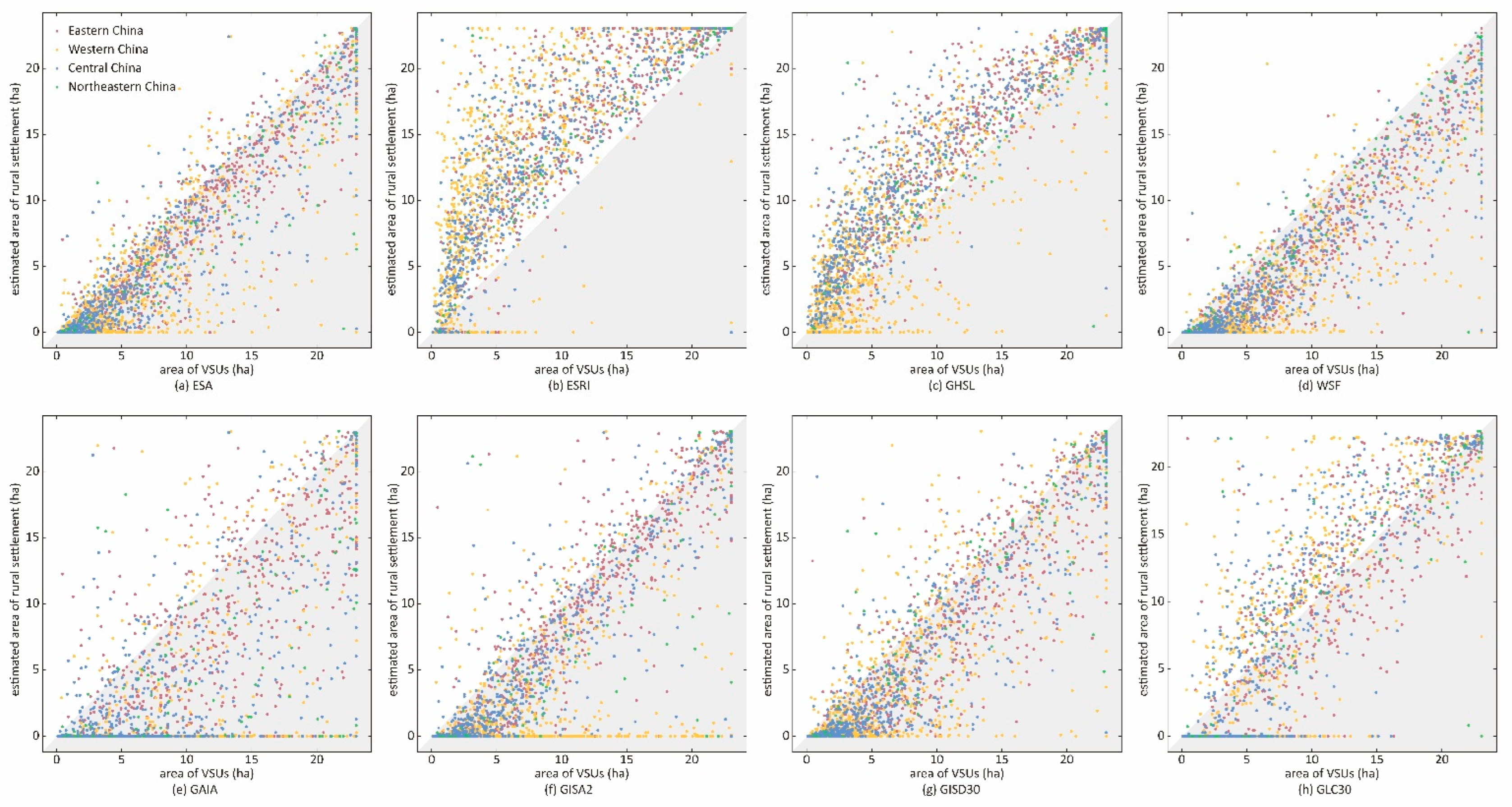
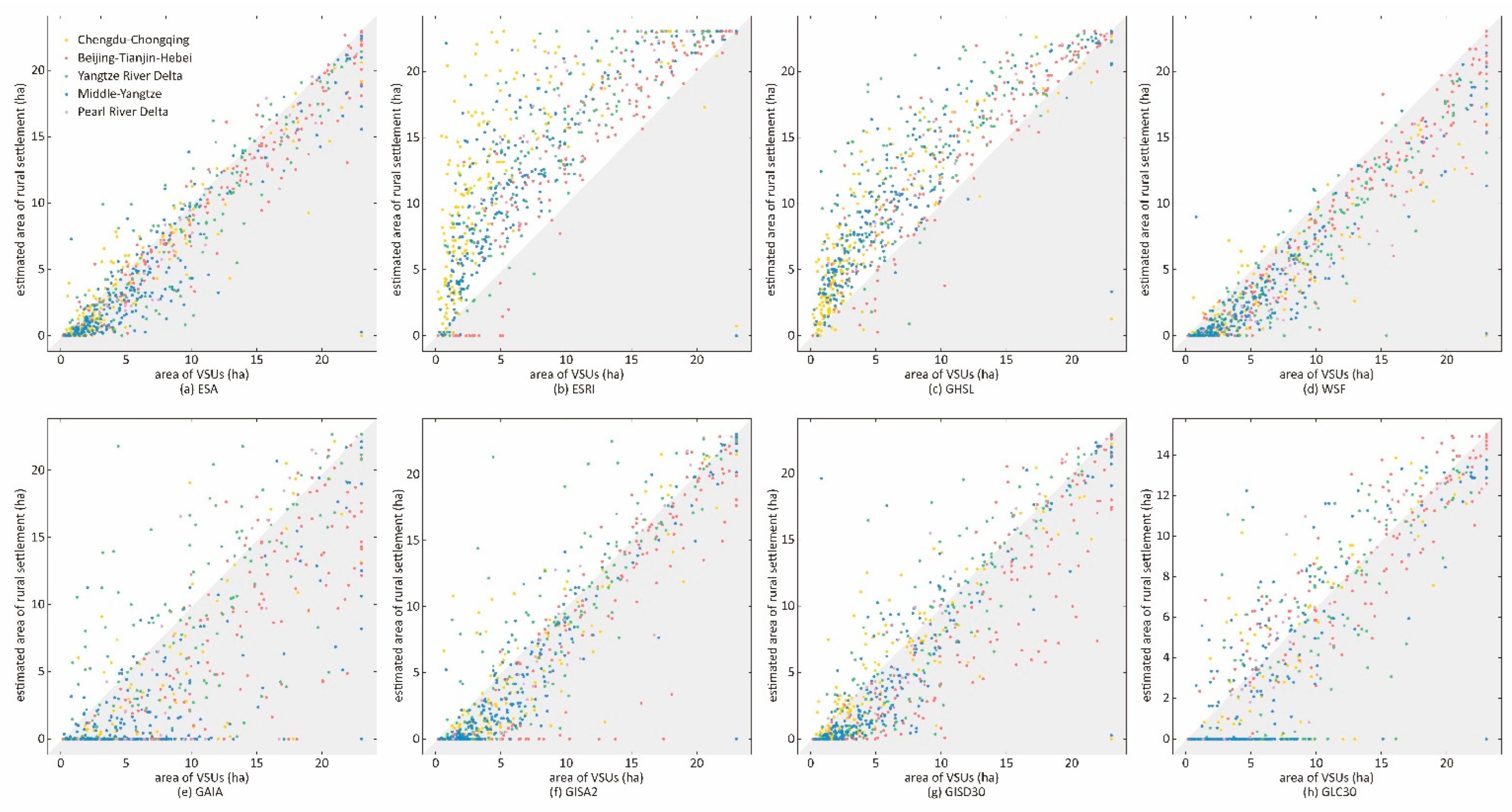
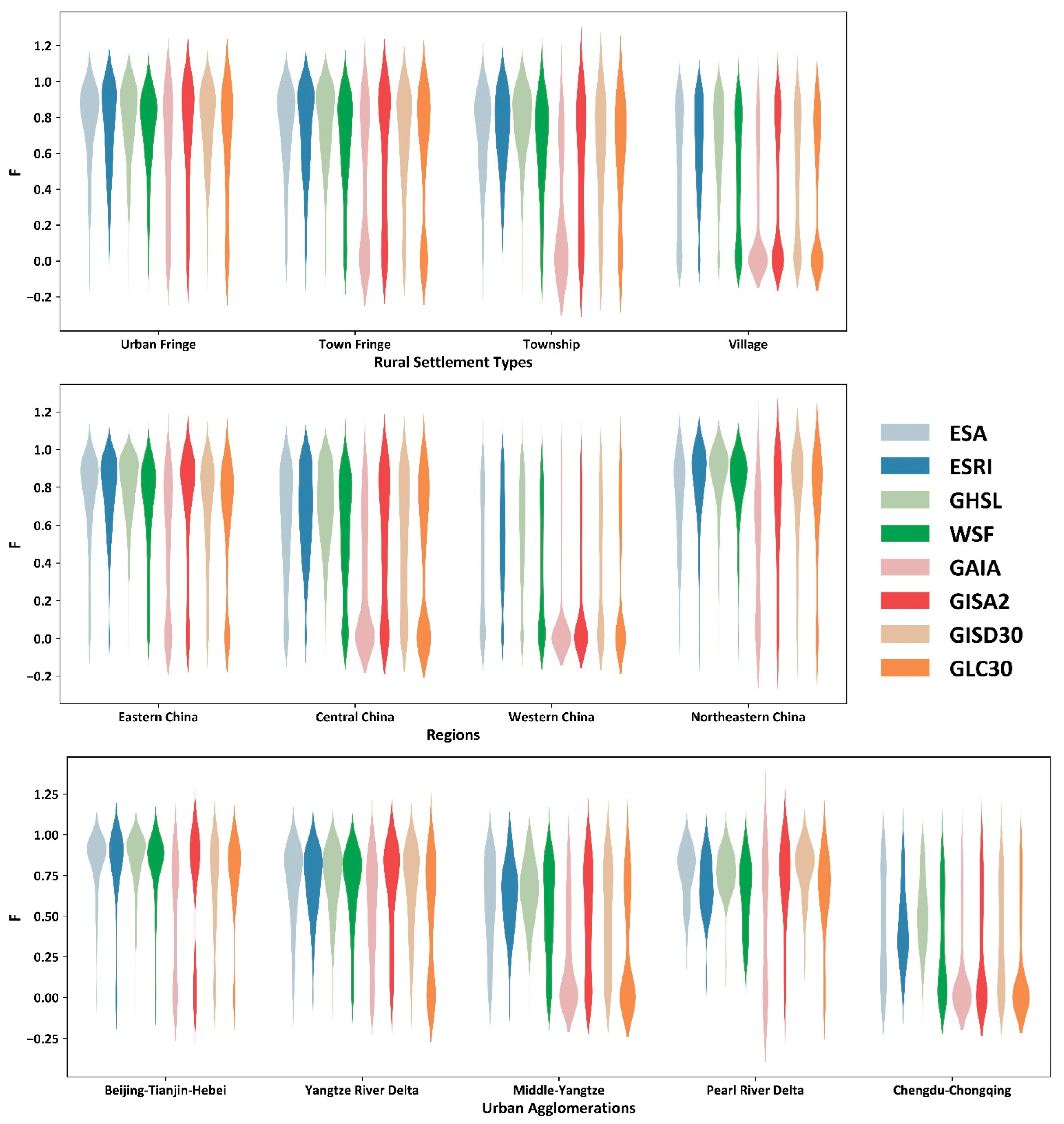
| Abbr. | Map | Producer | Resolution | Earliest/Latest Release Time | Time Cover | Map Type | Map Representations Related to Rural Settlement | Primary Data Sources |
|---|---|---|---|---|---|---|---|---|
| ESRI Land Cover | Sentinel-2 10 m Land Use/Land Cover | ESRI | 10 m | 2021/2022 | 2017–2021 | Thematic (10 classes) | Built-up area | Sentinel-2 |
| WSF | World Settlement Footprint | European Space Agency (ESA) and the German Aerospace Center (DLR) | 10 m | 2020/2021 | 2015; 2019 | Binary (settlement/not settlement) | Human settlement | Sentinel-1 and Landsat 8 |
| WorldCover | ESA WorldCover | European Space Agency (ESA) | 10 m | 2021 | 2020 | Thematic (11 classes) | Impervious surface | Sentinel-1 and Sentinel-2 |
| GHS-BUILT-S2 (from the GHSL series) | Global Human Settlement Layer Built-up Grid Derived from Sentinel-2 Global Image | European Commission-Joint Research Centre | 10 m | 2020 | 2018 | Continuous (built-up probability values) | Built-up area | Sentinel-2 |
| FROM-GLC10 | Finer Resolution Observation and Monitoring of Global Land Cover | Tsinghua University | 10 m; 30 m | 2019 | 2017 | Thematic (10 classes) | Impervious surface | Sentinel-2 |
| GUF | Global Urban Footprint | German Remote Sensing Data Center (DFD) | 12 m | 2017 | 2011 | Binary (settlement/not settlement) | Human settlement | TerraSAR-X and TanDEM-X |
| GISD30 | Global 30 m Impervious Surface Dynamic Dataset | Aerospace Information Research Institute, Chinese Academy of Sciences | 30 m | 2022 | 1985–2020 | Continuous (built year values) | Impervious surface | Landsat 4, 5, 7 and 8 |
| GISA2.0 | Global Impervious Surface Area 2.0 | Wuhan University | 30 m | 2022 | 1972–2019 | Continuous (built year values) | Impervious surface | GISA1.0, GAIA, GAUD, GHSL |
| GLC30 | GlobeLand30 | National Geomatics Center of China | 30 m | 2014/2021 | 2000; 2010; 2020 | Thematic (10 classes) | Artificial surface | Landsat Series (2000; 2010; 2020) and GF-1 (only 2020 version) |
| GAUD | Global Annual Urban Dynamics | Global Annual Urban Dynamics | 30 m | 2020 | 1985–2015 | Continuous (built year values) | Urban area | Landsat Series |
| GAIA | Annual Maps of Global Artificial Impervious Area | Tsinghua University | 30 m | 2019 | 1978–2018 | Continuous (built year values) | Impervious surface | Landsat Series |
| GMIS | Global Man-made Impervious Surface | NASA Goddard Space Flight Center and the Department of Geographical Sciences at the University of Maryland | 30 m | 2017 | 2010 | Continuous (impervious surface percentage) | Impervious surface | Landsat Series |
| HBASE | Global Human Built-up And Settlement Extent | 30 m | 2017 | 2010 | Binary (HBASE/ROAD/not HBASE); Continuous (HBASE percentage) | Built-up area | Landsat Series | |
| MGUP | MODIS Global Urban Extent Product | Wuhan University | 250 m | 2021 | 2001–2018 | Binary (urban area/not urban area) | Urban area | MODIS |
| MCD12Q1 v6 | The MODIS Land Cover Type Product | Land Processes Distributed Active Archive Center (LP DAAC) | 500 m | 2019/2021 | 2000–2020 | Thematic (17 classes) | Urban and Built-up Lands | MODIS |
| MOD500 | MODIS 500m Map of Global Urban Extent | University of Wisconsin and Boston | 500 m | 2009 | 2001/2002 | Binary (urban area/not urban area) | Urban area | MODIS |
| Map Under Test | |||
|---|---|---|---|
| Presence | Absence | ||
| Reference map | Presence | True Positive (TP) | False Negative (FN) |
| Absence | False Positive (FP) | Ture Negative (TN) | |
| ESA | ESRI | GHSL * | WSF | GAIA | GISA2.0 | GISD30 | GLC30 | 8-Map Mean | ||
|---|---|---|---|---|---|---|---|---|---|---|
| Total Omissions | 126 | 87 | 92 | 190 | 1148 | 723 | 347 | 862 | 446.88 | |
| Omission rate (%) | 5.41 | 3.74 | 3.95 | 8.17 | 49.33 | 31.07 | 14.91 | 37.04 | 19.2 | |
| (a) By Type (%) | Class Size | |||||||||
| City Fringe | 0.69 | 0 | 0.68 | 1.38 | 11.03 | 7.59 | 0.69 | 11.72 | 4.22 | 145 |
| Town Fringe | 1.89 | 0.75 | 1.13 | 1.89 | 31.7 | 14.34 | 5.28 | 24.15 | 10.14 | 265 |
| Township | 0 | 0 | 1.72 | 3.45 | 56.9 | 18.97 | 8.62 | 17.24 | 13.36 | 58 |
| Village | 6.46 | 4.57 | 4.67 | 9.74 | 54.6 | 35.66 | 17.59 | 41.47 | 21.85 | 1859 |
| (b) By region (%) | ||||||||||
| Eastern China | 0.32 | 1.74 | 0.15 | 1.74 | 25.24 | 11.51 | 3.79 | 16.72 | 7.65 | 634 |
| Central China | 2.7 | 1.95 | 0.45 | 4.05 | 40.93 | 19.04 | 11.54 | 37.03 | 14.71 | 667 |
| Western China | 11.35 | 6.64 | 9.42 | 16.17 | 74.73 | 54.82 | 26.02 | 53.32 | 31.56 | 934 |
| Northeastern China | 0 | 1.09 | 0 | 1.09 | 18.48 | 11.96 | 3.26 | 11.96 | 5.98 | 92 |
| (c) By Urban Agglomeration (%) | ||||||||||
| Beijing-Tianjin-Hebei | 0.65 | 5.84 | 0.65 | 1.3 | 26.62 | 18.83 | 5.84 | 8.44 | 8.52 | 154 |
| Chengdu-Chongqing | 7.37 | 1.05 | 0.52 | 10.53 | 66.32 | 47.89 | 23.16 | 70 | 28.36 | 190 |
| Middle-Yangtze | 2.67 | 0.89 | 0.44 | 1.33 | 45.78 | 17.78 | 11.56 | 50.67 | 16.39 | 225 |
| Pearl River Delta | 0 | 0 | 0 | 0 | 35.48 | 6.45 | 0 | 6.45 | 6.05 | 31 |
| Yangtze River Delta | 0 | 0 | 0 | 1.41 | 11.27 | 4.93 | 2.11 | 28.87 | 6.07 | 142 |
| Overall Accuracy | Producer’s Accuracy | User’s Accuracy | F-score | ||
|---|---|---|---|---|---|
| 10 m Resolution | ESA | 0.851 (0.846) | 0.505 (0.560) | 0.764 (0.847) | 0.566 (0.627) |
| ESRI | 0.765 (0.760) | 0.896 (0.937) | 0.538 (0.564) | 0.636 (0.666) | |
| GHSL * | 0.836 (0.833) | 0.806 (0.840) | 0.663 (0.659) | 0.669 (0.697) | |
| WSF | 0.836 (0.825) | 0.428 (0.503) | 0.790 (0.928) | 0.511 (0.600) | |
| 30 m Resolution | GAIA | 0.756 (0.736) | 0.272 (0.539) | 0.411 (0.813) | 0.297 (0.586) |
| GISA2.0 | 0.818 (0.823) | 0.405 (0.588) | 0.588 (0.853) | 0.438 (0.637) | |
| GISD30 | 0.831 (0.820) | 0.457 (0.538) | 0.705 (0.830) | 0.504 (0.593) | |
| GLC30 | 0.805 (0.718) | 0.475 (0.754) | 0.452 (0.718) | 0.445 (0.707) |
| Map Quality | Description | Recommended Maps |
|---|---|---|
| Most Recent Map | The maps are recent. | ESRI provides global maps from 2015 to 2021, updated annually. ESA and GISD30 offer versions for 2020. |
| Long Time Coverage | Aggregating the built-up year on one map as pixel values. | GISD30 published a time-aggregated map for 1985–2020. GISA2.0 provides maps of earlier dates (1972–2019) but is inferior to GISD30 in all aspects. |
| Highest Comprehensive Map Accuracy | Strong agreement with the VSUs, providing the best balance of PA and UA. | GHSL is capable of mapping as many rural settlements as possible while simultaneously providing a high likelihood that the pixels obtained are rural settlements. |
| Highest Producer’s Accuracy (PA) | As many as rural settlements detected | ESRI can cover the most extensive rural settlement pixels. GHSL with a low threshold (e.g., 10%) follows ESRI closely. |
| Highest User’s Accuracy (UA) | Less false positives. | WSF has the highest UA regardless of the omission rate. ESA ranks second in UA, but its PA is higher than that of WSF. |
| Best for Estimating Area | Capability to estimate the area of a rural settlement. | ESA estimates area accurately in city fringes, town fringes, and township areas. GHSL with a low threshold value is suitable for estimating the area of small rural settlements of less than 5 hectares. WSF is the most accurate product in estimating the area of buildings. |
| Low Omission Rate | Fewer rural settlements ignored | ESRI (globally optimal) has the lowest omission rates in all rural settlement types. GHSL (locally optimal) has the lowest omission rates (all less than 1%) in 5 urban agglomerations and three regions (excluding Western China). |
| Roads | Including roads | GHSL can capture finer concrete paths. ESA only detects wide arterials. |
| Excluding roads | WSF only depicts the presence of buildings and completely removes any roads between buildings. | |
| Functional Types | High accuracy in the city fringes, town fringes, or townships (relatively developed rural settlements) | GHSL performs best, followed by ESRI, ESA, and WSF. GISD30 can support rural settlements in city fringes. |
| High accuracy in villages (relatively less developed rural settlements) | GHSL is the only map used for pixel-scale analysis; other maps should consider omission rates across regions. |
Publisher’s Note: MDPI stays neutral with regard to jurisdictional claims in published maps and institutional affiliations. |
© 2022 by the authors. Licensee MDPI, Basel, Switzerland. This article is an open access article distributed under the terms and conditions of the Creative Commons Attribution (CC BY) license (https://creativecommons.org/licenses/by/4.0/).
Share and Cite
Wang, N.; Zhang, X.; Yao, S.; Wu, J.; Xia, H. How Good Are Global Layers for Mapping Rural Settlements? Evidence from China. Land 2022, 11, 1308. https://doi.org/10.3390/land11081308
Wang N, Zhang X, Yao S, Wu J, Xia H. How Good Are Global Layers for Mapping Rural Settlements? Evidence from China. Land. 2022; 11(8):1308. https://doi.org/10.3390/land11081308
Chicago/Turabian StyleWang, Ningcheng, Xinyi Zhang, Shenjun Yao, Jianping Wu, and Haibin Xia. 2022. "How Good Are Global Layers for Mapping Rural Settlements? Evidence from China" Land 11, no. 8: 1308. https://doi.org/10.3390/land11081308
APA StyleWang, N., Zhang, X., Yao, S., Wu, J., & Xia, H. (2022). How Good Are Global Layers for Mapping Rural Settlements? Evidence from China. Land, 11(8), 1308. https://doi.org/10.3390/land11081308






